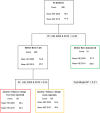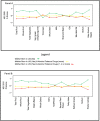A multicenter study of diet quality on birth weight and gestational age in infants of HIV-infected women
- PMID: 27863014
- PMCID: PMC5575978
- DOI: 10.1111/mcn.12378
A multicenter study of diet quality on birth weight and gestational age in infants of HIV-infected women
Abstract
We determined factors associated with diet quality and assessed the relationship between diet quality, birth weight, and gestational age in a prospective national multicenter cohort study. We evaluated diet quality with the Healthy Eating Index (HEI, scale 0-100) in the third trimester of pregnancy with three 24-hr multiple-pass dietary recalls in 266 HIV+ women enrolled in the Pediatric HIV/AIDS Cohort Study. Covariates included demographics, food security, pre-pregnancy body mass index, HIV disease severity, substance use, and antiretroviral exposures. A two-stage multivariate process using classification and regression trees (CART) followed by multiple regression described HEI tendencies, controlled possible confounding effects, and examined the association of HEI with birth weight and gestational age. To assess the stability of the CART solution, both the HEI 2005 and 2010 were evaluated. The mean HEI scores were 56.1 and 47.5 for the 2005 and 2010 HEI, respectively. The first-stage CART analysis examined the relationship between HEI and covariates. Non-US born versus US-born mothers had higher HEI scores (15-point difference, R2 = 0.28). There was a secondary partition due to alcohol/cigarette/illicit drug usage (3.5-point difference, R2 = 0.03) among US-born women. For the second-stage CART adjusted multiple regression, birth weight z-score was positively related to HEI 2005 and 2010 (partial r's > 0.13, P's ≤ 0.0398), but not gestational age (r = 0.00). We conclude that diet quality among HIV+ women is associated with higher birth weight. Despite the influence of a large cultural effect and poor prenatal behaviors, interventions to improve diet in HIV+ women may help to increase birth weight.
Keywords: HIV; birth weight; dietary quality; healthy eating index; pregnancy.
© 2016 John Wiley & Sons Ltd.
Conflict of interest statement
The authors declare that they have no conflicts of interest.
Figures



Similar articles
-
Poor diet quality in pregnancy is associated with increased risk of excess fetal growth: a prospective multi-racial/ethnic cohort study.Int J Epidemiol. 2019 Apr 1;48(2):423-432. doi: 10.1093/ije/dyy285. Int J Epidemiol. 2019. PMID: 30590563 Free PMC article.
-
Mother's dietary quality during pregnancy and offspring's dietary quality in adolescence: Follow-up from a national birth cohort study of 19,582 mother-offspring pairs.PLoS Med. 2019 Sep 12;16(9):e1002911. doi: 10.1371/journal.pmed.1002911. eCollection 2019 Sep. PLoS Med. 2019. PMID: 31513597 Free PMC article.
-
Adherence to a healthy eating index for pregnant women is associated with lower neonatal adiposity in a multiethnic Asian cohort: the Growing Up in Singapore Towards healthy Outcomes (GUSTO) Study.Am J Clin Nutr. 2018 Jan 1;107(1):71-79. doi: 10.1093/ajcn/nqx003. Am J Clin Nutr. 2018. PMID: 29381790 Free PMC article.
-
Offspring body size and metabolic profile - effects of lifestyle intervention in obese pregnant women.Dan Med J. 2014 Jul;61(7):B4893. Dan Med J. 2014. PMID: 25123127 Review.
-
Use of the Healthy Eating Index in Intervention Studies for Cardiometabolic Risk Conditions: A Systematic Review.Adv Nutr. 2021 Jul 30;12(4):1317-1331. doi: 10.1093/advances/nmaa167. Adv Nutr. 2021. PMID: 33460430 Free PMC article.
Cited by
-
Third Trimester Vitamin D Status Is Associated With Birth Outcomes and Linear Growth of HIV-Exposed Uninfected Infants in the United States.J Acquir Immune Defic Syndr. 2019 Jul 1;81(3):336-344. doi: 10.1097/QAI.0000000000002041. J Acquir Immune Defic Syndr. 2019. PMID: 31021992 Free PMC article.
-
Association of Fatty Acid Signatures with HIV Viremia in Pregnancy.AIDS Res Hum Retroviruses. 2024 Apr;40(4):257-267. doi: 10.1089/AID.2023.0040. Epub 2023 Oct 30. AIDS Res Hum Retroviruses. 2024. PMID: 37772708 Free PMC article.
-
Diet Quality and Weight Status are Predicted by Federal Nutrition Assistance Program Participation, Health, and Demographics.Curr Dev Nutr. 2025 Jul 9;9(8):107505. doi: 10.1016/j.cdnut.2025.107505. eCollection 2025 Aug. Curr Dev Nutr. 2025. PMID: 40761945 Free PMC article.
-
Behavioral and Physical Activity Interventions for HAND.Curr Top Behav Neurosci. 2021;50:479-501. doi: 10.1007/7854_2018_79. Curr Top Behav Neurosci. 2021. PMID: 30694458 Free PMC article. Review.
-
Maternal anemia and preterm birth among women living with HIV in the United States.Am J Clin Nutr. 2021 Jun 1;113(6):1402-1410. doi: 10.1093/ajcn/nqaa441. Am J Clin Nutr. 2021. PMID: 35104854 Free PMC article.
References
-
- Baer Wilson, D. , & Nietert, P. J. (2002). Patterns of fruit, vegetable, and milk consumption among smoking and nonsmoking female teens. American Journal of Preventive Medicine, 22, 240–246. - PubMed
-
- Breiman, L. F. J. , Olshen, R. A. , & Stone, C. J. (1984). Classification and regression trees. Belmont, CA: Wadsworth.
Publication types
MeSH terms
Substances
Grants and funding
LinkOut - more resources
Full Text Sources
Other Literature Sources
Medical

